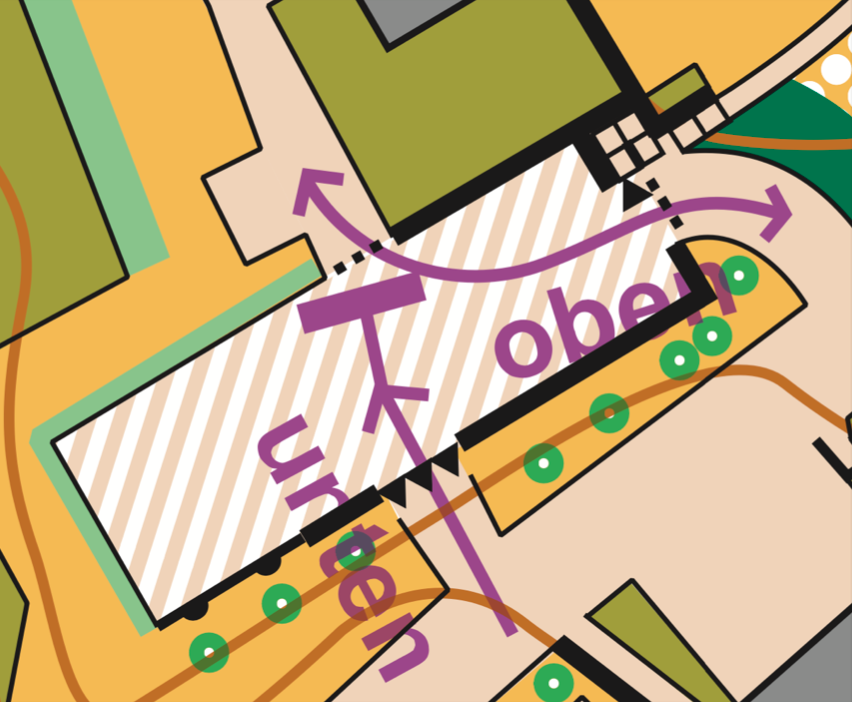Urban Orienteering
Written by Jörg Höfer on
We rely on the goodwill of authorities and landowners to enter and use residential areas with gardens, commercial and shopping arcades, school and university grounds, parks, etc.
Therefore, we expect all participants to show respect and consideration towards third parties, especially towards impaired and elderly passers-by, children and prams.
In principle, the traffic regulations (German StVO) must be observed. In both the qualification and the final of the individual races there will be predominantly no or little motor vehicle traffic. No vehicle traffic is to be expected in the area of the relay.
On both days, heavy use of the grounds by cyclists is to be expected. Here, too, we ask for consideration and caution.
Sprint orienteering: Rules
Sprint orienteering has special rules. These include the map display and the sprint orienteering specific rules in the competition regulations (from German Federation DTB and IOF):
a. Every competitor should be familiar with the map display for sprint orienteering maps. Attention is drawn to the changes in the display standard for sprint orienteering maps valid since the beginning of this year and the explanatory article on o-Sport.de: https://o-sport.de/news/aenderungen-in-der-issprom-2019/ (German)
b. One of the special features of sprint orienteering is that some map symbols in the terrain may not be stepped on or crossed. The map representation is decisive (not the subjective perception of the runner). For clarity, the organiser will put up additional barriers in some places. The aforementioned prohibitions apply with barriers and of course also without additional barriers.
Relevant for the Hamburg-OL competitions are: Impassable wall, impassable fence and impassable boundary (purple) may not be crossed. Buildings, forbidden area (olive), very dense vegetation (green-black), restricted areas and construction sites (both purple) may not be entered.
The swiss orienteering information sheet explains the essential do's and don'ts very clearly.
Display of 2 levels
A special feature is running in areas with two levels. These can be "simple" bridge situations, but also complex situations, e.g. multi-storey car parks or a second level that can be run on over a larger area. 2 levels do not occur that often and the representation standard is still new. At the the individual races, competitors will often encounter 2 levels. We recommend that all competitors familiarise themselves with the presentation. Practical or dry training builds confidence in the new presentation: https://o-sport.de/news/aenderungen-in-der-issprom-2019/
Here are some practical tips on how to recognise and assess these areas:
a. Basically, the upper level is shown on the map. For the lower level, only where it can be walked on is shown, but without further details.
b. The striped representation is used for areas that can be walked on at two levels. The colour describes the walkability of the upper level.
-> in both examples, the upper level is paved ground (concrete, asphalt, or similar).
c. black triangles ("saw teeth") describe the access to the lower level. The "saw teeth" are the so-called bridge or tunnel entrance symbol. "Saw teeth" occur as wide entrances in the form of several black triangles next to each other, but also as a single black triangle for narrow entrances (e.g. narrow entrance or in combination with stairs). At "sawtooths" it is forbidden to change levels (no jumping down or climbing up). Changing levels is possible, e.g. via stairs.
-> in the "example multi-storey car park" there is access to the lower level either from the south (3 black triangles) or in the north-eastern part via a staircase (1 black triangle, change of level).
d. black dashed lines describe boundaries of the lower level that are not already recognisable by other symbols. With this symbol no access or exit of the lower level is possible, but of course walking on the upper level is possible here. Examples are the left and right side walls of a bridge subway or the boundary walls of a larger lower level.
-> Access to the upper level via the passage/tunnel symbol on the north and east sides (but no access to the lower level).
-> in the example, access to the upper level in the western part (surmountable wall, hedge), but not via the impassable walls in the eastern part.


